It used to be easy to review trucks.
They were the most basic vehicles on the road – built to work and not to be comfortable. There was a body on a frame with a bed in the back and you picked the length and the number of doors – and that about covered it.
Now it’s just getting started.
How about an onboard generator that can power a welder? A gear shifter that reclines – so as to make the center console a worktable? Seats that turn into beds? Your pick of 11 different grills? How about 700 miles on a tank of gas – and the ability to burn no gas at all for several of those miles? 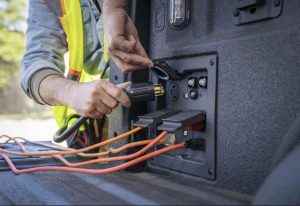
That’s just the Cliff’s Notes version.
What It Is
The F-150 is Ford’s half-ton pickup.
Its main rivals are the Chevy Silverado 1500, Ram 1500 and (to a lesser degree) the Toyota Tundra and Nissan Titan, which are the same size and similar in general layout but not available in the almost without-limit cab/bed/trim/engine/equipment configurations that are offered by Ford, Chevy and Ram.
Prices start at $28,490 for a base XL trim in rear drive, with a 6.5 foot bed, a two-door regular cab and a 3.3 liter V6 engine. An eight foot bed and 4WD are are available with this trim.
Supercabs start at $33,025 for the XL with rear-drive and the 3.3 V6, which can be swapped out in XLT and Lariat trims for either a twin-turbo 2.7 liter V6 or a 5.0 liter V8 and with your pick of 5.5, 6.5 or eight-foot bed lengths.
SuperCrews have four full-size doors and are available in XL, XLT, Lariat, King Ranch, Platinum and range-topping Limited ($70,825) trims. Depending on the trim, you’ll find – or can order – engines ranging from the 3.3 V6 to the 2.7 twin turbo V6 to the 5.0 V8 to a twin-turbo 3.5 V6 to a 3.0 liter Powerstroke diesel V6. 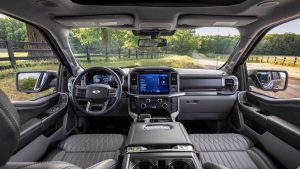
There is also a new-for-2021 Power Boost hybrid-drive option – which can be selected with the 3.5 V6 – and the also-new ProPower generator option, which summons as much as 240 volts and 7,200 watts – power enough to power a house, almost.
What’s New
The ’21 F-150 is all-new . . . already.
Trucks used to be redesigned as infrequently as once every 15 or 20 years. Being simple things. Since they no longer are, they are “all new” much sooner.
What’s Good
Order your truck almost any way you like.
Plug your RV into this truck.
Sleeps better than some hotels.
What’s Not so Good
You have to buy the more expensive trims before you can buy some of the available engines.
SuperCrews aren’t available with an eight-foot bed.
Aluminum body shaves weight but increases repair costs if damaged.
Some half-ton trucks are offered with two – and maybe three – engines. One – the Toyota Tundra – comes standard and only with just one.
The F-150 uniquely offers you a choice of five. Six, technically – since one of the five can be paired with a hybrid-electric system, if you like.
The standard engine in the XL and XLT trims is a 3.3 liter V6 without a turbo but with an almost-diesel 12:1 compression ratio. It produces 290 horsepower and 290 ft.-lbs. of torque. It can be paired with rear-drive or 4WD and comes standard with a 10 speed automatic transmission. It can also be ordered with what Ford calls the ProPower system, which uses the engine to generate electrical power – as much as 2 kW with this engine – that can be used to run tools and such from a variety of plugs mounted inside the truck and on the driver’s side of the truck’s bedwall.
A 2.7 liter V6 with two turbos is optional. This one produces 325 horsepower and a very stout 400 ft.-lbs. of torque – matching the torque output of the much larger 5.7 liter V8 that’s standard in the Toyota Tundra (401 ft. lbs.) though not quite matching its horsepower (381).
This engine is also available with the ProPower system – and the power increases to 2.4 kW.
For those who like traditional power, the next-available engine is a 5.0 liter V8 that makes 400 horsepower and 410 ft.-lbs. of torque. This engine is basically the same engine that powers the Mustang GT.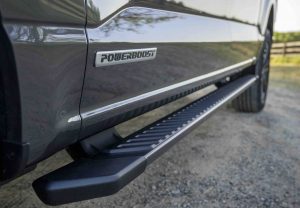
It can also power your tools if ordered with the ProPower system.
But if you want to power your RV – no kidding – buy the 3.5 liter twin-turbo V6 hybrid with the ProPower system. It generates 7.2 kilowatts of power, enough to power a 240 volt/30amp accessory such as a welder – or even run most of your house in the event of a blackout.
Or your RV, in the event of a road trip.
This version of the F-150 can also go farther than a Prius on a full tank (and a full charge). It has a range of 700 miles – and because it’s a hybrid, you’re not limited by its range. Just stop for gas – and this truck recharges itself, while you don’t wait.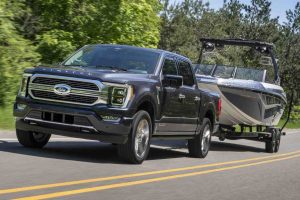
This one also hauls – up to 13,100 lbs., the highest tow rating in the half-ton class.
And it hauls – with 430 horsepower and 570 ft.-lbs.of torque on tap. This is a six-second to 60 truck, too.
Or, skip the hybrid version and get the 400 horsepower version of the 3.5 V6 – which still makes 500 ft.-lbs. of torque, more torque than any of its rivals’ V8s, excepting the new Tremor version of the Ram 1500 – which is powered by the same supercharged 6.2 liter V8 that first appeared in the Challenger and Charger Hellcat. That one makes 650 ft.-lbs. of torque and an astounding 702 horsepower.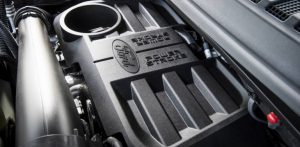
But it doesn’t power your Airstream.
There’s one more engine to consider. Ford also offers a 3.0 liter turbodiesel V6 that makes 250 horsepower and 440 ft.-lbs. of torque. This engine can pull almost as much as the hunky hybrid – up to 12,100 lbs.- and goes farther on a gallon than the F-truck’s other non-hybrid engines – in part because it comes standard with a larger 26 gallon tank – for less than it costs to buy the hybrid, which is only available in the King Ranch, Limited and Platinum versions of the F-150.
Modern half-ton trucks are larger – specifically, wider – than “heavy duty” 2500 and even 3500 series pick-ups were as recently as the ‘90s.
Which of course, isn’t very recently.
But the point remains that today’s 1500s are the biggest – and widest – trucks of their type ever made. The ’21 F150 is almost 84 inches wide – not counting its exterior side mirrors – vs. 79 inches for a 1990 F250.
You notice this difference on country roads with narrow lanes and not much shoulder. If two of these things encounter each other on a dirt road, there’ll be some careful maneuvering goin’ on, like Titanic and Britannic carefully trying not to hit the other at the docks. 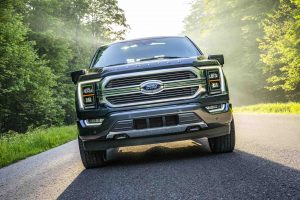
But the maneuvering is easy, in terms of the inputs. You are not wrestling with no-power (or too much power) steering and a three-on-the-tree. Trying to keep an old truck going straight was often a challenge even when it was new.
Now you are behind the wheel of a luxury sport sedan that happens to have a bed. That is no editorial exaggeration – and not about the bed. The F-150 is as easy to drive as any car once it’s out to sea – and much more comfortable than most of them. The spaciousness – more of it than in the fullest-sized luxury sedan – is a reward unto itself and no wonder trucks are more popular than cars and used primarily for just driving – with the hauling and towing being incidental perks. It is probable that they would still sell better than cars even if they didn’t have beds at all – because what they are is what big American cars used to be but aren’t anymore and haven’t been for decades.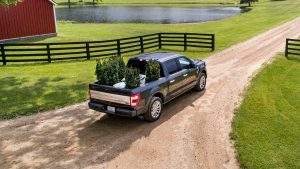
This truck is also a high-performance sports car – so to speak. Equipped with the 3.5 turbo or the 5.0 V8, it is quicker than most of them – which is also its own reward.
You can also configure this truck’s personality to suit.
The GT’s 5 liter V8 makes the right sounds – if you like the sound of a classic muscle truck. The diesel makes the right truck sounds. And the 3.5 V6 makes almost no sound at all, which is weird at first since this is a truck. Flooring it is an almost spiritual experience in that you feel an ethereal surge of unstoppable force propelling you toward the light – with almost no audible indication of mechanical propulsion.
It just goes.
It can also go silent – no noise at all – if you opt for the hybrid V6. This also takes a little getting-used-to, especially when you first “start” the truck. You push the button – and hear nothing. Is it on? It is hard to tell. Your primary indication is that the steering wheel -which is electrically power-assisted – can be easily turned. Go ahead, put the gear selector in Drive.
Now, roll.
And hear nothing except perhaps the gravel crunching under your tires.
This silent drive is something no other half-ton truck offers right now. Nor the capability to roll for 700 miles without stopping – farther than a Prius, with the ability to pull a pair of them behind you.
Ford’s ten-speed automatic (used with all of the available engines) deserves a word, too. It feels like a six-speed even though it has four more gears, three of them overdrive gears, one succeeding the next until you’re in tenth (0.63) at 70 and the engine is turning about 2,000 RPM, about the same as a fast idle.
This isn’t so much about economy as it is about drivability. Old trucks at 70 felt like you were doing 120 even when they were brand-new. Their engines would be screaming around 3,500 RPM at 70 – because their transmission didn’t have three overdrive ratios on top.
It is also about power – without killing mileage.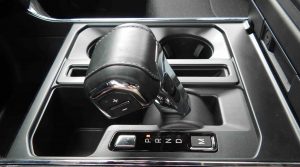
Because of the multiple overdrive gearing (and other fuel-saving features such as the F-truck’s “active” grill shutters and, of course, the weight-savings of its entirely aluminum body) the V8 version – which makes 400 horsepower – gets 17 city, 24 highway (16/22 with 4WD) which is not a little bit better than the a’90 F-150’s horrendous 12 city,16 highway . . . with the 4.9 liter six cylinder engine.
Which made 145 horsepower.
In its defense, the old F-150 with that 4.9 straight six may not have gone as far, or nearly as fast – but they did last almost forever.
Many are still around.
At The Curb
To notice the differences between the ’21 and the ’20 F-150 requires taking a closer look. In the cab, for instance – where you’ll find such thoughtful features as seats that fold practically flat, creating an almost-bed. And a gear selector that folds down, creating a completely flat workspace – or dining table – on the center console.
It’s amazing no one thought of these features before.
There’s also a stamped-in ruler on the tailgate’s surface, so you never have to search for your ruler. There are also twin clamping points to secure a 2×4 for cutting, even. 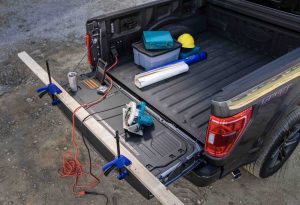
If you buy the 3.5 V6 with the ProPower option, you will find a four-prong generator/welder-style outlet and other high voltage outlets in the bed. This gives you the option of not hooking up your RV at campsites.
Just run the truck to power up your ‘fridge.
You can also still get a pretty basic work truck, too. The XL trim comes standard with manual roll-up windows and rubber (not carpet) on the floorboards. And you can get it with a regular cab and an eight-foot bed – two things the 2021 Ram 1500 no longer offers, the Classic version having been discontinued. The ’21 Ram does offer a hybrid variant but it’s not nearly as powerful and doesn’t offer silent running or the capability to power your Airstream.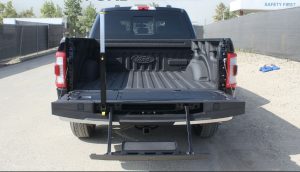
The Chevy Silverado is still available in regular cab configuration – and you can still get it with an eight-foot bed, too. But you can’t get it with anything like the Ford’s ability to serve as your own personal – and mobile – electrical utility plant.
The Rest
The F-150, like all current half-tons, has bedwalls as tall used to be found only in 2500/3500 series trucks. This “look” has become very popular because it looks super-rugged but it isn’t very practical for everyday use. Even a very tall man such as this writer (I’m 6ft. 3) can just barely finger-touch the bed floor – standing on my tip-toes. This makes getting things like bags of feed into and out of the bed more of a chore. You have to heave them over – and drag them out, after having dropped the tailgate. Lifting heavy stuff over the bed walls is almost impossible.
And getting in the bed requires a ladder. Literally. Ford builds a fold-out one into the bed, along with a pole to hold onto.
The other 1500s are similar and it seems silly to me. But people seem to be okay with it which is why all 1500s are made this way now.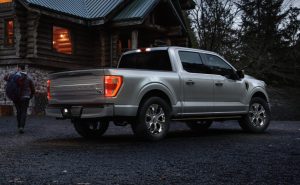
Uniquely, the Ford’s skin is made of aluminum. This has the pro of shedding about 400 pounds from the curb weight vs. steel – and the con of being more easily damaged and more expensive to fix if it is damaged, because aluminum is more challenging to weld.
Watch out for those deer!
The Bottom Line
This truck does so much it almost overwhelms you – whether you’re writing about it or trying to figure out which of the so-many configuration/options to buy.
But there’s no question that it does more than any other half-ton on the market right now, as well as things none of the others can do at all.
. . . .
Got a question about cars, Libertarian politics – or anything else? Click on the “ask Eric” link and send ’em in!
If you like what you’ve found here please consider supporting EPautos.
We depend on you to keep the wheels turning!
Our donate button is here.
If you prefer not to use PayPal, our mailing address is:
EPautos
721 Hummingbird Lane SE
Copper Hill, VA 24079
PS: Get an EPautos magnet or sticker or coaster in return for a $20 or more one-time donation or a $10 or more monthly recurring donation. (Please be sure to tell us you want a magnet or sticker or coaster – and also, provide an address, so we know where to mail the thing!)
My eBook about car buying (new and used) is also available for your favorite price – free! Click here. If that fails, email me at [email protected] and I will send you a copy directly!















Perfect California homeowner truck. You will need all that fuel and generator when the green power gets turned off or the wind does not blow. Or you can just sleep, watch Netflix and cook in the driveway.
Holy crap, 240 volt 7200 watt generator??!! I live in hurricane country, where just about everyone has a generator. The one that I have for disasters doesn’t even have that much capacity!
I have ’20 F150 XL, 2.7L turbo, reg cab, 8ft bed. I like it a lot. The turbo is great. I get about 20mpg mixed driving. 21+ on highway road trips. Disabling the ASS is a simple switch on the dashboard. The 10spd works well. I think it even “learns” that I’m going down my home mountain road and keeps a lower gear on the descent. The high pressure fuel pump makes some noise when it first turns on, but after running 10min it quiets out. After that, it’s amazing how quiet that engine is. The 5.0L ones are very hard to find. But I have passing power with a load of mulch and going 70 down the freeway. Oil filter is right on top. Reasonable access to spark plugs and coil packs with V6 layout. Overall pretty happy with it.
Hey, those straight 6’es are great engines! If I were going for a classic I would almost get one of those over the 5.0 or 5.8L OHV V-8’s. That engine is *still* being made: It is installed in aircraft tug tractors!
Good stuff, Tom!
After I get done with this Hyundai Accent… I have a new F250 with the 7.3 liter monster motor under the hood… stay tuned!
Tom, a paperclip fixes the ASS button permanently. jump it from behind, takes 5 minutes to remove the covers. No more ASS.
I love how the center console converts into a flat surface – very useful feature.
Hi Handler,
I like it, too – though I would like it more if the system were mechanically rather than electronically actuated. A simple latch mechanism that let you fold it forward. Instead, there’s an electric motor that lowers it when you push a button. How long will that last? This is a truck, after all…
That’s such a nice truck that I actually looked up its local availability! Needless to say, the base model XT isn’t at any of the local dealers. The cheapeste F-150 available in my area is priced in the low-mid 30s…
“Now you are behind the wheel of a luxury sport sedan that happens to have a bed. ” – EP
Agree 100%. my 20 ram rides better than my 18 300S. The rams interior is nicer too. I think the rams interior won some ‘best luxury sedan’ award??
It won’t beat the 300 in a curvy road race, but I bet it holds its own.
After my first ride in my 20 ram i said ‘this truck is the large sedan I’ve been after for 20+ years’.
That generator feature is really cool. Bet a lot of small contractors like it too. I guess the question for them becomes: what does it cost to run 6-8 hours a day vs. a dedicated generator?
Amen, Chris!
And they’re sending me the 250 soon…
My understanding is to save money, Ford is using the same body for F-150’s, as the 250 and 350 models, and only altering the frame and running gear to handle the additional weight and hauling capability of the larger trucks.
Hi Saxons,
There are similarities – but also differences. The F150 and F250 have different stampings for the front fenders and hood, for instance. The front clips are also different and I think the rear a swell. But the beds may indeed be virtually the same, as well as the “cage” for the cab. I will try to compare the F150 I still have with the F250 that’s coming!
My father’s new Expedition is as quick as a Mustang Mach 1 from 2003.
I just hope that engine holds up…..
‘This “look” has become very popular because it looks super-rugged but it isn’t very practical for everyday use.’ — EP
Lord, no. Ergonomically — depending on your height — a seat surface between about 24 and 30 inches off the ground allows you to place your butt on the seat with feet still touching the ground, and then smoothly swing your legs inside the door. Many crossovers and older pickups fall in this convenient range.
Compact sedans with low ground clearance drop well below the optimum level for tall people. Thus the grab handle above the door opening to support your weight while dropping one’s torso down to a squat, then scrunching the legs inside with your knees in your face.
On the other end of the spectrum with ‘the look,’ a step becomes necessary even for the long-legged to clamber up into the vehicle, usually with the help of a grab handle over the door as well. Largely, this awkwardness is a triumph of aesthetics over function, imposing inconvenience (or worse, for those with physical limitations) on every entry and exit.
Not being able to reach over the bedwalls (or the front fenders, to service the engine) is a categorically unacceptable price to pay for ‘the look,’ which says, ‘Me Tarzan! Me big and tuff! Me bad-ass!’ … as you bite the head off a small animal to prove you merit this honking big land yacht.
We all buy clothes that fit us. Why do people put up with vehicles that don’t even come close to being the right size? Next year I expect Ford will offer bad-ass custom tattoos on the exterior of its bad-ass trucks.